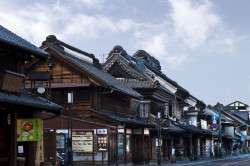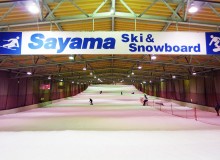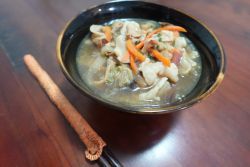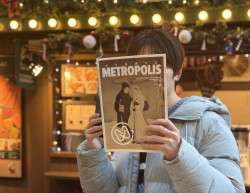
October 12, 2006
Lijiang to Lhasa—by motorcycle
Sixteen motorcyclists cross the Roof of the World
By Metropolis
Originally published on metropolis.co.jp on October 2006

Photo by Chloe Reuter
The idea of a motorcycle trip from Lijiang in China’s Yunnan province to Lhasa in Tibet was born in Shanghai. A group of friends with a penchant for Chang Jiang 750cc bikes—modeled on the vintage BMW R71—decided to put their machines to the test. Eight motorcycles with one driver and one sidecar passenger on each would attempt the 2,000km journey. The group would begin in Lijiang, travel north to connect with the Sichuan-Tibet highway, cross over into Tibet, and drive west to Lhasa. Conservative estimates put the length of the journey at 10 days.
A couple of months later, I’m sitting in the sidecar inhaling exhaust and wearing seriously unbecoming biker gear. We’re on the main square in the historic town of Lijiang—all cobbled streets, mazelike alleys and canals, thus its nickname as the “Venice of the East.” It’s our first morning, and the mechanic who will be with us for the next 10 days, Mr. Lu, shows up in a pristine three-piece pinstripe suit, a cigarette dangling from his lips. Spirits are high as we roar out of Lijiang amid achingly high decibels and clouds of smoke. A huge group of people has assembled to watch our intriguing performance, and they wave us off incredulously.
The first leg is to Zhongdian, also known as “Shangri-La.” Our hearty optimism is short-lived: 10 minutes later we are sitting by the side of the road with two bikes leaking petrol. This is the first stop of so many that I soon stop counting. Luckily, Lu has a MacGyver-like ability to reconstruct engines with whatever he can lay his hands on: stone, rope, bits of rubber, coins. He never ceases to amaze.
For the first couple of days, as we pass through Zhongdian and Deqin, the road is delightfully smooth and winds through forests of fragrant pine trees. We feel like we could be in the Alps as we drive through snow-peaked mountains for hundreds of kilometers. After three days, we make it onto the Tibet-Sichuan Highway, which was built in 1950 just after the Communists won the Civil War.
The term “highway,” though, is back-breakingly misleading: most of its 2,000km are nothing more than single lanes of dusty dirt tracks. After rainfall the roads are muddy and like an obstacle course. We have to watch out for boulders, potholes, yaks, steep ravines and pedestrians. It’s an extraordinary feat of engineering—much of the highway has literally been carved out of the mountain. Massive bridges, almost as impressive as the Golden Gate, cross river after river, and every mountain pass is ornately decorated with Tibetan prayer flags. They flutter in the wind, and the snow is littered with colored prayer paper. But there is almost no traffic.
On the road from Markam to Wamda, we come across a surreal sight as we reach the top of a 4,600m pass: 200 horses, each carrying two rattan baskets and sporting red flags. They approach us and I run through the snow to get a closer look. Suddenly, a heavily panting white man appears. Dan is from Liverpool and looks cold and ghastly pale. “Bloody Hell!” he says. “I feel like I’m about to die!” Spotting his drenched flimsy canvas trainers, I can well believe him. “Retracing the ancient tea trading route,” he tells me between gasps of thin air. “We’re walking from Zhongdian to Lhasa. The horses are carrying tea, which we’ll auction off in Lhasa to raise money for Tibetan schools.” It will take another six weeks before they reach the end of their trip. Getting back into my cramped sidecar feels like a luxury.
As we travel closer to Lhasa, the scenery becomes more barren and the roads more difficult. For hours, our speed does not rise above 25km/hour. But in the midst of these isolated and arid mountains, there are pockets of lusciousness. Irrigation canals have been carved into the mountains, bringing water and life from glaciers to the remotest hamlets. Immaculately tended terraced wheat fields glisten in the most vibrant green. The architecture starts changing—it becomes more Tibetan, with flat, square white houses that have ornately colored window frames. People, too, are changing, from Han Chinese to Tibetan. Children come running when they catch a glimpse of us or hear us coming.
The days are long: on average we’re driving eight hours a day, but making steady progress. Every evening we manage to find a roof and a decent meal, and we attract huge crowds whenever we stop. We rest in bleak border towns that have been forcibly populated by Han Chinese in the government’s attempt to drown out the Tibetan culture and religion; every hotel, shop and business is run by Han. But the names of the towns still roll off the tongue like mythical places: Wamda, Rawu, Tangmai, Ngapo Zampa.
We drive along valleys, skirting rivers and meandering in the shadows of 7,000m snow-capped mountains. We picnic by rivers at 4,500m. The scenery is outstanding and so varied. We travel from spring to autumn, to winter, and back to spring in a day. There are deep gorges with turquoise rivers running through them and still surprisingly little traffic. Even in towns there are remarkably few cars. As we approach Lhasa, we pass an increasing number of pilgrims—they prostrate every three steps on their slow and painstaking journey to the Jokhang Temple.
Arriving in Lhasa is like coming back to reality. The town has greatly expanded since I was last here eight years ago. The old Tibetan village is now dwarfed by nondescript modern Chinese architecture, and there are packs of tourists lining up to see the temples. One can only worry that with the recent opening of a train line from China, the influx of sightseers will become even greater. We sit in an internet café checking email and reconnecting. How I wish we could stay disconnected for a while longer, and keep driving.
The Children of China Foundation
Throughout the trip, we raised money for the Children of China Foundation, which seeks to improve the health and welfare of orphans throughout the country. The foundation works to support orphanages in Hunan province by providing medicine, clothing, toys and basic necessities. It also helps recruit and train care workers and foster care providers. See www.childrenofchina.co.uk for more info.
From Japan, fly ANA, JAL or Northwest airlines to Beijing, where you can catch a non-stop flight to Lijiang. Traveling from mainland China into Tibet takes a fair amount of preparation. The simplest option is to go with a Chinese tour group like CITS (www.citsusa.com). There are quite a few police checks along the route, so make sure your paperwork is in order. A majority of towns you pass through have basic accommodation. Expect dorm-type rooms and sporadic hot water—if any running water at all. Hotels are mostly Chinese-owned, and local restaurants serve up spicy Sichuan and Yunnan dishes. The best season to attempt the trip is from mid-April to October, when the roads are opened after the winter snow.
[geo_mashup_map]







